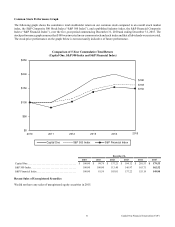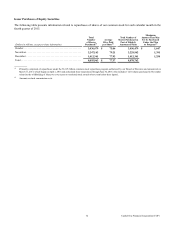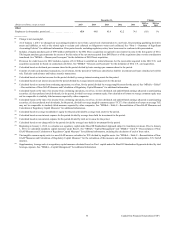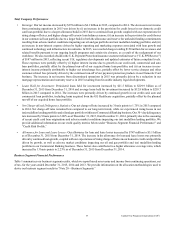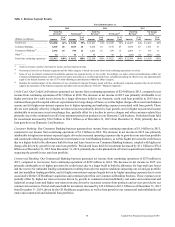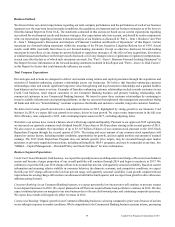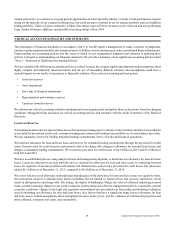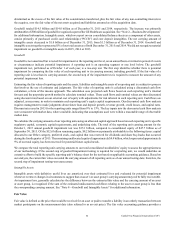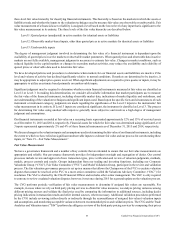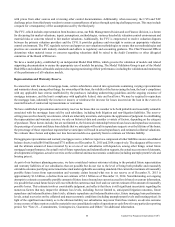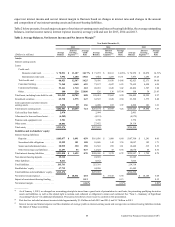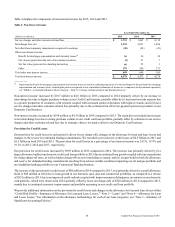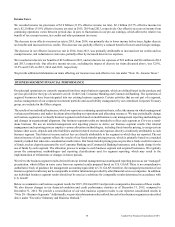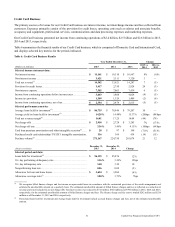Capital One 2015 Annual Report Download - page 60
Download and view the complete annual report
Please find page 60 of the 2015 Capital One annual report below. You can navigate through the pages in the report by either clicking on the pages listed below, or by using the keyword search tool below to find specific information within the annual report.41 Capital One Financial Corporation (COF)
In addition to the allowance for loan and lease losses, we review and assess our estimate of probable losses related to binding
unfunded lending commitments, such as letters of credit and financial guarantees, and unfunded loan commitments on a quarterly
basis. The factors impacting our assessment generally align with those considered in our evaluation of the allowance for loan and
lease losses for the Commercial Banking business. Changes to the reserve for losses on unfunded lending commitments are recorded
through the provision for credit losses in the consolidated statements of income and to other liabilities on the consolidated balance
sheets.
Although we examine a variety of externally available data, as well as our internal loan performance data, to determine our
allowance for loan and lease losses and reserve for unfunded lending commitments, our estimation process is subject to risks and
uncertainties, including a reliance on historical loss and trend information that may not be representative of current conditions and
indicative of future performance. Accordingly, our actual credit loss experience may not be in line with our expectations. We
provide additional information on the methodologies and key assumptions used in determining our allowance for loan and lease
losses for each of our loan portfolio segments in “Note 1—Summary of Significant Accounting Policies.” We provide information
on the components of our allowance, disaggregated by impairment methodology, and changes in our allowance in “Note 6—
Allowance for Loan and Lease Losses.”
Finance Charge and Fee Reserves
Finance charges and fees on credit card loans, net of amounts that we consider uncollectible, are included in loan receivables and
revenue when the finance charges and fees are earned. We continue to accrue finance charges and fees on credit card loans until
the account is charged-off; however, when we do not expect full payment of billed finance charges and fees, we reduce the balance
of our credit card loan receivables by the amount of finance charges and fees billed but not expected to be collected and exclude
this amount from revenue. Total net revenue was reduced by $732 million, $645 million and $796 million in 2015, 2014 and 2013,
respectively, for the estimated uncollectible amount of billed finance charges and fees. The finance charge and fee reserve totaled
$262 million as of December 31, 2015, compared to $216 million as of December 31, 2014.
We review and assess the adequacy of the uncollectible finance charge and fee reserve on a quarterly basis. Our methodology for
estimating the uncollectible portion of billed finance charges and fees is consistent with the methodology we use to estimate the
allowance for incurred losses on the principal portion of our credit card loan receivables.
Asset Impairment
In addition to our loan portfolio, we review other assets for impairment on a regular basis in accordance with applicable impairment
accounting guidance. This process requires significant management judgment and involves various estimates and assumptions.
Our investment securities, goodwill and intangible assets represent a significant portion of our total assets excluding loans.
Accordingly, below we describe our process for assessing impairment of these assets and the key estimates and assumptions
involved in this process.
Investment Securities
We regularly review our investment securities for other-than-temporary impairment (“OTTI”) using both quantitative and
qualitative criteria. If we intend to sell a security in an unrealized loss position or it is more likely than not that we will be required
to sell the security prior to recovery of its amortized cost basis, the entire difference between the amortized cost basis of the security
and its fair value is recognized in income. If we do not intend to sell the security and it is not more likely than not that we will be
required to sell the security before recovery of our amortized cost, we evaluate other quantitative and qualitative criteria to determine
whether a credit loss exists. Our evaluation requires significant management judgment and a consideration of many factors,
including, but not limited to, the extent and duration of the impairment; the health of and specific prospects for the issuer, including
whether the issuer has failed to make scheduled interest or principal payments; recent events specific to the issuer and/or industry
to which the issuer belongs; the payment structure of the security; external credit ratings; the value of underlying collateral and
current market conditions. Quantitative criteria include assessing whether there has been an adverse change in expected future
cash flows. See “Note 4—Investment Securities” for additional information.
Goodwill and Intangible Assets
Goodwill resulting from business combinations prior to January 1, 2009 represents the excess of the purchase price over the fair
value of the net assets of businesses acquired. Goodwill resulting from business combinations after January 1, 2009, is generally


